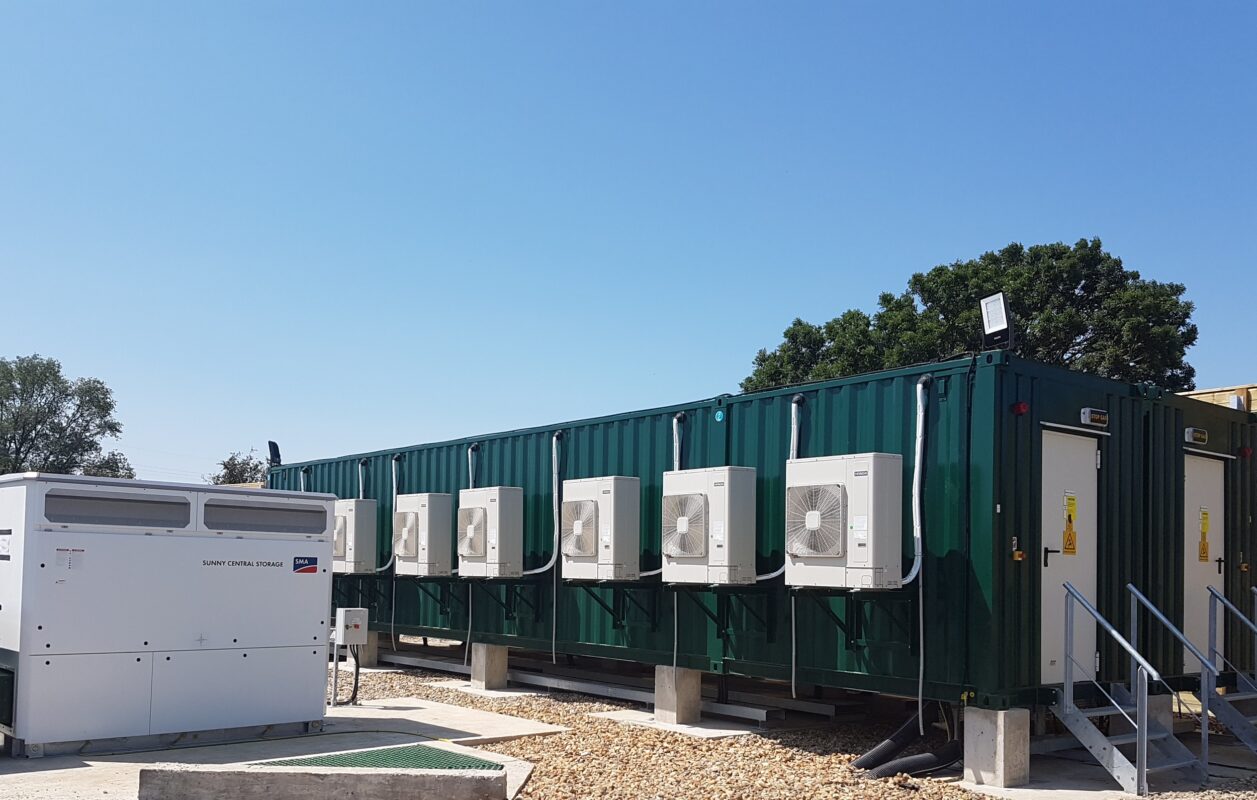
As of December, Gresham House has eight battery storage projects in construction. Image: Gresham House
Gresham House Energy Storage Fund is transitioning towards a trading-centric business model, with the company to upgrade all of its enhanced frequency response (EFR) battery storage sites to two-hour durations.
In its full year results to 31 December 2021, the energy storage fund outlined how its underlying operational portfolio EBITDA rose 172% year-on-year to £42.5 million, while its underlying operational portfolio revenues were up 170% to £51.4 million.
Of these revenues, 82% were generated from frequency response (FR) contracts, while the remainder came from trading (11.5%), Capacity Market (CM) contracts (5.8%) and TRIAD income (0.5%).
This is further broken down into the various FR services, with 59.5% of revenues coming from Dynamic Containment (DC) (£30.64 million), while Firm Frequency Response (FFR) generated 3.9% (£2 million) and Enhanced Frequency Response generated 18.7% (£9.63%).
However, in Q4 this split varied slightly, with FR representing 71.%, trading 22.1% and CM 6.2% – a change which Gresham House said it had anticipated, with it expected for some time that the FR market would become saturated.
Indeed, Gresham House said the commoditisation of the FR market has revealed the underlying attractiveness of trading, where it said the revenue potential isn’t significantly lower than what has been achievable from FR. The company added that as prices for FR services have fallen, and electricity price volatility continues to increase, trading is becoming key to profit maximisation.
However, revenues from trading are expected to be lower than Dynamic Containment in 2022, with the company’s financial forecasting having embedded a like for like decline in forecasted revenues per MW in 2022 as it transitions to a trading-centric business model.
Additionally, Gresham House is now intending to invest in portfolio projects with at least a two-hour battery life, with its board having now agreed to upgrade all existing EFR projects to two hours as well as building out much of its pipeline to two hours.
This transition to two hours reflects the shift to trading as opposed to FR of the portfolio’s revenue mix, with Gresham House stating this justifies projects with longer durations in general.
It added that increased EBITDA from two-hour projects should result in an improved return on capital employed.
The company also pointed to the increased power prices seen across the latter half of 2021 and so far into 2022 as a justification for greater durations.
It detailed how the daily average system price trebled in 2021 from £81/MWh in 2021 to £242/MWh. There were 136 days with an average system price of at least £200/MWh compared to 11 days in 2020.
There have also been record numbers of extremely high prices with 36 half hours at prices of £1,000/MWh and above in 2021.
To illustrate the potential of building larger batteries to capture this, Gresham House gave the example of 9 September 2021, when a one-hour asset could have earned the equivalent of 8.8 days worth of DC revenue at the £17/MWh cap, whereas a 3.5-hour asset could have earned a full month of DC revenue from a single cycle of the battery.
Gresham House is now looking to make changes to its investment policy, with proposed amendments including investing up to 10% of gross asset value (GAV) in shovel-ready project rights. This is expected to simplify and accelerate the acquisition processes and reduce the total acquisition cost by 5-10%.
The company is also proposing to invest up to 30% of GAV in certain international markets, with this replacing its existing ability to invest up to 10% of GAV in Ireland. Gresham House said this would increase EBITDA and net asset value (NAV) over time by exporting core competencies, including scale advantages, business model and operational capabilities to international markets.
In its results, Gresham House also detailed two incidents at two of its battery storage sites, one involving vandalism at the distribution network operator (DNO) connection for Rufford in May 2021, which left the site offline for six months.
This incident was reported to the police, with all damaged equipment since replaced and the site now online and performing at full capacity.
The second incident involved trespassing and theft of materials at a separate site in September 2021. Gresham House said that due to the nature of the materials taken and the damage to the perimeter fencing, manned guarding was installed around the perimeter of the site until remedial works were carried out and the site could be deemed safe.
The company said these incidents “tested and proved the effectiveness” of its health, safety and security procedures while offering learning opportunities. It will now look to implement new ideas across the portfolio to further enhance site security and safety.
In the year, Gresham House invested £49 million in 110MW of operational capacity, taking its total to 425MW. As of 31 December 2021, there were 8 projects totalling a further 415MW under construction and an additional 717MW due to enter construction.
Last year saw Gresham House partner Irish developer Strategic Power Projects to develop a solar and storage pipeline with a combined capacity of over 1GW.
John Leggate CBE, chair of Gresham House Energy Storage Fund plc said the year saw the company deliver key milestones and “gain significant momentum”. He also referenced the current Russian invasion of Ukraine, with the company closely following the global response and the impact this might have on financial markets and power price volatility.
“In terms of impact on the company's longer-term outlook, for the moment, the indications are pointing towards a much faster rollout of renewable energy globally with an associated increasing demand for energy storage projects,” he said.

